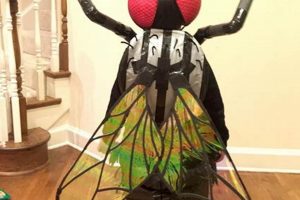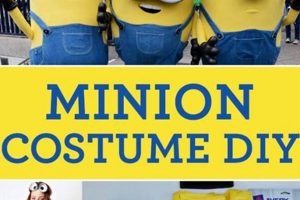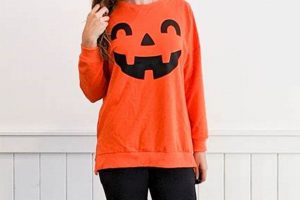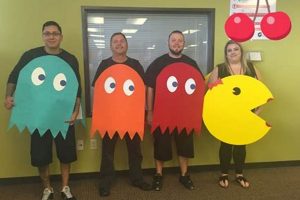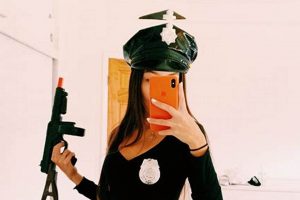Creating a homemade outfit inspired by the iconic 1969 music festival involves replicating the distinctive fashion trends of that era. This undertaking frequently includes crafting garments and accessories that reflect the styles popular at the event, such as fringed vests, tie-dye shirts, and peace sign jewelry. The objective is to embody the visual aesthetic associated with the festival through self-made components.
The motivation for assembling such an attire often stems from a desire for cost-effectiveness and personalization. Mass-produced versions might lack authenticity or be prohibitively expensive. Constructing the outfit allows for a customized approach, incorporating individual creativity and ensuring a unique presentation. Furthermore, it provides a tangible connection to a pivotal moment in cultural history, celebrating the values of peace, love, and musical expression.
The following sections will detail specific methods and considerations for designing and fabricating individual elements of a self-fashioned ensemble evocative of this celebrated occasion. Material selection, construction techniques, and stylistic choices will be examined to facilitate the creation of an authentic and impactful representation.
Tips for Assembling an Authentic Outfit Inspired by the 1969 Music Festival
Achieving a credible recreation of the festival’s iconic fashion requires careful attention to detail and adherence to period-appropriate aesthetics. The following guidelines provide essential advice for constructing a visually compelling and historically accurate ensemble.
Tip 1: Prioritize Authentic Fabrics: Natural materials such as cotton, linen, and suede should be favored over synthetics. These fabrics align with the prevalent textile choices of the era and contribute to a more genuine appearance.
Tip 2: Master the Art of Tie-Dye: Tie-dye is a quintessential element. Employ traditional techniques using fiber-reactive dyes on natural fabrics. Experiment with various patterns, but avoid overly modern or digitally-inspired designs.
Tip 3: Embrace Fringed Embellishments: Fringing was a common decorative feature. Incorporate it on vests, jackets, and bags, utilizing suede or leather strips for an authentic textural element. Ensure the fringe is evenly spaced and appropriately sized for the garment.
Tip 4: Select Appropriate Footwear: Opt for sandals, moccasins, or bare feet to mirror the footwear choices prevalent at the event. Avoid modern athletic shoes or overly stylized boots that would detract from the overall authenticity.
Tip 5: Accessorize Thoughtfully: Incorporate elements such as peace sign necklaces, headbands, and round sunglasses. Ensure these accessories are consistent with the period and avoid overly large or garish pieces.
Tip 6: Consider Garment Fit and Silhouette: Loose-fitting and flowing garments were characteristic of the era. Avoid overly tailored or form-fitting styles. The silhouette should be relaxed and comfortable.
Tip 7: Research Historical References: Consult photographs and videos from the 1969 festival to accurately represent the clothing styles and accessories. This visual research will inform design choices and ensure historical accuracy.
These tips emphasize the importance of material selection, construction techniques, and stylistic accuracy in creating a faithful representation of the festival’s fashion. Attention to these details will elevate the ensemble from a generic costume to a historically informed tribute.
The subsequent sections will explore specific garment construction techniques and offer advice on sourcing appropriate materials for this creative endeavor.
1. Fabric Selection
The selection of appropriate textiles is fundamental to crafting a credible representation for a self-made outfit evocative of the 1969 music festival. The chosen fabrics significantly influence the garment’s visual authenticity, tactile qualities, and overall historical accuracy.
- Natural Fibers and Authenticity
Employing natural fibers such as cotton, linen, and hemp is crucial. These materials were prevalent during the era and possess a characteristic drape and texture distinct from modern synthetic alternatives. The use of these fibers directly impacts the perceived authenticity of the garment, making it more closely aligned with the historical context.
- Weight and Drape Considerations
The weight and drape of the fabric affect the garment’s silhouette. Lightweight fabrics with a soft drape, like voile or muslin, are appropriate for flowing dresses and blouses, while heavier materials such as denim or canvas are suitable for vests and jackets. Correctly matching fabric weight to garment type enhances the outfit’s visual harmony.
- Dyeability and Color Saturation
The ability of the fabric to accept dyes, particularly for tie-dye applications, is paramount. Natural fibers readily absorb dyes, allowing for vibrant and saturated colors. Fabrics with poor dye absorption can result in faded or uneven color patterns, diminishing the overall aesthetic. Fiber-reactive dyes are recommended for longevity and colorfastness.
- Texture and Visual Appeal
The texture of the chosen fabric contributes to the garment’s visual appeal. Fabrics with a slightly slubbed or textured surface can add depth and character, reflecting the homespun or handcrafted aesthetic often associated with the festival attire. Conversely, excessively smooth or polished fabrics may appear anachronistic.
Ultimately, meticulous consideration of fiber content, weight, dyeability, and texture is indispensable for creating a self-made ensemble that effectively embodies the sartorial spirit of the 1969 music festival. The careful selection of fabrics not only enhances the garment’s visual appeal but also reinforces its historical authenticity.
2. Tie-dye technique
The application of tie-dye is intrinsically linked to the creation of an authentic representation of attire inspired by the 1969 music festival. The prevalence of tie-dyed garments during the event establishes it as a defining visual element. The selection and execution of the technique directly impact the overall credibility of the self-made outfit. Inaccurate or poorly executed tie-dye can detract from the intended aesthetic, while a well-executed pattern contributes significantly to the ensemble’s fidelity. For example, spiral and bullseye patterns, frequently observed in historical documentation of the event, enhance the authenticity. Conversely, abstract or digitally-inspired patterns compromise the representation’s integrity.
The practical application of this understanding involves several key considerations. Fiber-reactive dyes are necessary to achieve vibrant, lasting color
on natural fabrics like cotton or linen. Traditional folding and binding methods are essential to replicate authentic patterns. Furthermore, understanding the effects of dye concentration and immersion time allows for precise control over the final design. Incorrectly applied dye can result in faded colors, blurred lines, or unintended patterns. Historical resources, including photographs and instructional guides from the era, provide valuable insights into achieving accurate results.
In summary, the integration of appropriate tie-dye techniques is crucial for the success of a homemade festival-inspired outfit. Mastering these techniques demands attention to detail, adherence to historical methods, and careful selection of materials. The result is a visually compelling and historically accurate garment that effectively embodies the spirit of the 1969 event.
3. Fringe application
The incorporation of fringe constitutes a significant design element in constructing a self-fashioned outfit inspired by the 1969 music festival. The presence and character of fringe contribute substantially to the perceived authenticity of the garment, reflecting a prevalent aesthetic of the era.
- Material Selection for Fringe
The selection of appropriate materials for fringe is paramount. Suede or leather strips are commonly employed to emulate the texture and visual appeal of garments from that period. Synthetic alternatives, such as plastic or rayon, detract from the historical accuracy. The chosen material should exhibit a natural drape and a slightly weathered appearance to align with the intended aesthetic.
- Application Techniques and Placement
The method of attachment and the placement of fringe are crucial details. Fringe is typically sewn onto garment edges, such as the hem of a vest or the sleeves of a jacket. The spacing and length of the fringe should be consistent and proportional to the garment. Uneven or poorly spaced fringe diminishes the visual impact and historical credibility.
- Color Coordination and Contrast
The color of the fringe should complement or contrast effectively with the base garment. Earth tones, such as brown, tan, or cream, are frequently employed to maintain a cohesive aesthetic. Contrasting colors can be used strategically to highlight specific areas of the garment, but the color choices should remain within the palette representative of the era.
- Fringe Length and Density
The length and density of the fringe impact the overall visual effect. Longer fringe creates a more dramatic and flowing appearance, while shorter fringe offers a more subtle embellishment. The density of the fringe, or the number of strands per unit length, should be adjusted to achieve the desired level of texture and visual interest.
These considerations regarding material, application, color, and dimensions highlight the critical role of fringe in realizing a historically plausible outfit. Careful attention to these details elevates the representation from a generic costume to a credible homage to the sartorial styles associated with the 1969 music festival. Successful implementation of fringe reinforces the garment’s visual authenticity and its connection to the cultural context of the event.
4. Accessory choices
The selection of accessories wields considerable influence on the overall success of a homemade ensemble inspired by the 1969 music festival. Accessories function as critical augmentations, capable of either reinforcing or undermining the intended aesthetic. The inclusion of period-appropriate items, such as round sunglasses, peace sign necklaces, and woven headbands, enhances the ensemble’s fidelity to the historical context. Conversely, anachronistic accessories, like modern digital watches or contemporary jewelry designs, detract from the outfit’s authenticity. The accessories serve to contextualize and complete the overall image, transforming individual garments into a cohesive representation of the festival’s sartorial style.
The practical application of this principle involves careful consideration of accessory design, material, and scale. For example, choosing small, wire-framed round sunglasses aligns with the prevalent style of the era, while oversized, contemporary designs would be inappropriate. Similarly, selecting handcrafted-looking leather or beaded jewelry pieces enhances the outfit’s authenticity, whereas mass-produced, modern jewelry disrupts the intended effect. The scale of the accessories should also be proportionate to the garment and the wearer, avoiding items that are either too overpowering or too insignificant to contribute meaningfully to the overall look. Researching historical photographs and films from the festival provides valuable guidance on appropriate accessory styles and combinations.
In conclusion, accessories are integral to achieving a credible representation. Meticulous attention to accessory selection is paramount. Through careful curation, accessories elevate a self-fashioned outfit from a simple collection of garments to a compelling and historically resonant ensemble, effectively capturing the essence of the 1969 music festival’s iconic style.
5. Silhouette accuracy
Achieving a high degree of silhouette accuracy is paramount in the successful creation of attire inspired by the 1969 music festival. The overall shape and form of garments significantly contribute to the visual authenticity and historical plausibility of a self-made ensemble. Inaccurate silhouettes can immediately detract from the intended aesthetic, rendering the outfit a generic costume rather than a credible representation of the era’s fashion.
- Garment Volume and Fit
The volume and fit of clothing during that period favored looser, more flowing silhouettes. This contrasts sharply with more tailored or form-fitting styles. Replicating this relaxed fit requires careful attention to pattern selection and construction techniques. Examples include A-line dresses, bell-bottom pants, and oversized shirts. Deviations from this loose fit result in anachronistic appearances.
- Shoulder Line and Sleeve Construction
The shoulder line and sleeve construction are critical elements in defining the silhouette. Dropped shoulders, wide sleeves (such as bell sleeves), and unstructured tailoring were common features. Replicating these details necessitates an understanding of pattern drafting or modification to achieve the correct shape. Stiff or overly structured shoulders, or sleeves that are too narrow, compromise the silhouette’s accuracy.
- Skirt and Pant Shapes
Skirts and pants exhibited distinct shapes during the era. A-line skirts, maxi skirts, and bell-bottom pants were prevalent styles. Accurately recreating these shapes requires careful attention to pattern grading and fabric drape. Skirts that are too short or too fitted, or pants that lack the characteristic flare, detract from the ensemble’s historical accuracy.
- Layering and Overall Form
Layering played a significant role in creating the ov
erall silhouette. Vests, jackets, and shawls were frequently combined to add dimension and volume. The interplay of these layers contributed to a bohemian and unstructured aesthetic. Replicating this effect requires an understanding of how different garments interact to create a cohesive and visually authentic silhouette. Ignoring the layering aspect reduces the visual complexity and historical depth of the outfit.
Collectively, these facets demonstrate that the accurate reproduction of garment silhouettes is essential for creating a convincing portrayal of 1969 music festival attire. These elements are interconnected, with each contributing to the overall visual impression. Through diligent attention to pattern selection, construction techniques, and an understanding of historical context, a self-fashioned outfit can achieve a high degree of silhouette accuracy, effectively capturing the essence of the era’s unique fashion sensibilities.
Frequently Asked Questions
This section addresses common inquiries and clarifies key aspects pertaining to the creation of self-fashioned attire inspired by the 1969 music festival.
Question 1: What constitutes an authentic fabric choice for a DIY ensemble?
Authenticity necessitates the prioritization of natural fibers such as cotton, linen, suede, and denim. These materials were prevalent during the period and offer a characteristic texture and drape that distinguishes them from synthetic alternatives.
Question 2: How is tie-dye effectively incorporated into a DIY project?
Effective tie-dye application requires the use of fiber-reactive dyes on natural fabrics. Traditional folding and binding techniques, replicating patterns such as spirals or bullseyes, are essential for achieving a historically accurate representation.
Question 3: What is the appropriate method for applying fringe to a garment?
Fringe should be constructed from materials like suede or leather and sewn onto garment edges, such as vests or jackets. Consistent spacing and proportional length are crucial for maintaining visual harmony and historical credibility.
Question 4: Which accessories are suitable for completing a DIY ensemble?
Appropriate accessories include round sunglasses, peace sign necklaces, and woven headbands. Accessory design, material, and scale should align with the prevalent styles of the era to enhance the overall authenticity.
Question 5: How can silhouette accuracy be achieved in a self-made outfit?
Silhouette accuracy necessitates the replication of loose-fitting and flowing garments. Pattern selection and construction techniques should prioritize A-line dresses, bell-bottom pants, and oversized shirts, reflecting the characteristic shapes of the period.
Question 6: Why is attention to detail crucial in a DIY project of this nature?
Meticulous attention to detail in fabric selection, tie-dye technique, fringe application, accessory choices, and silhouette accuracy elevates the ensemble from a generic costume to a historically informed tribute, effectively capturing the spirit of the 1969 music festival.
In summary, careful consideration of these elements is crucial for crafting a successful self-fashioned outfit that accurately reflects the sartorial styles associated with the 1969 music festival.
The following section will provide resources and inspiration to aid in the creation of a credible and visually compelling ensemble.
Conclusion
This exploration of “diy woodstock costume” has underscored the importance of historical accuracy, meticulous detail, and informed decision-making in the construction of a credible representation. Fabric selection, tie-dye methodology, fringe application, accessory choices, and silhouette accuracy each contribute significantly to the overall authenticity of the ensemble. Successful execution requires a comprehensive understanding of the sartorial styles prevalent at the 1969 music festival.
The pursuit of crafting such an attire extends beyond mere costume creation; it represents an engagement with a pivotal moment in cultural history. This endeavor demands a commitment to research, craftsmanship, and an appreciation for the aesthetic values of the era. Individuals are encouraged to approach this undertaking with diligence, ensuring a final product that is both visually compelling and historically resonant. Further exploration of primary source materials and advanced sewing techniques will only enhance the final result.



